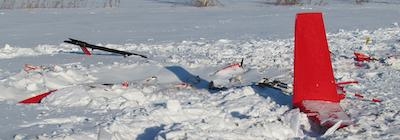Wed, Feb 20, 2019
Collision With Terrain Involving A Helicopter In Saint-Joachim-De-Courval, Quebec, Demonstrates The Risks Associated With Insufficient Recent Experience In Instrument Flight
In its investigation report (A18Q0016) released Monday, the Transportation Safety Board of Canada (TSB) underscored the risks posed by insufficient recent experience flying with reference to instruments, particularly in the case of night flights when unfavourable weather conditions are encountered and pilots lose visual reference to the ground.

On 01 February 2018, at about 1945 Eastern Standard Time, a privately operated Robinson R44 Raven I helicopter departed Saint-Georges de Beauce, Quebec, with the pilot and 2 passengers on board, on a night visual flight rules (VFR) flight to Saint-Alexis-de-Montcalm, Quebec. At 2032, the Canadian Mission Control Centre received a distress signal from the helicopter's emergency locator transmitter. At about 2135, the helicopter was found in a field in Saint-Joachim-de-Courval, near Drummondville. The helicopter was destroyed by the impact forces and a post-impact fire. All of the occupants were fatally injured.
The investigation determined that it is highly likely that the pilot encountered unfavourable weather conditions which led to a loss of visual references to the ground, and that he lost control of the helicopter as a result of spatial disorientation. Although the pilot held a valid pilot licence and a night rating, it is likely that, given his training and limited night flight experience, he did not have the necessary skills to handle a significant reduction in visual references to the ground.
The investigation highlighted several risk factors associated with night VFR flights. If pilots are not required by the Canadian Aviation Regulations (CARs) to maintain their instrument flying skills in order to use the privileges of a night rating, there is a risk that they will be unable to recognize spatial disorientation and react appropriately, increasing the risk of an accident resulting from a loss of control. Furthermore, if the CARs do not require pilots who conduct night VFR flights to undergo recurrent assessments in the form of dual instrument flights with a qualified instructor, there is an increased risk that, in the event of a loss of visual references, pilots may not be able to maintain control of the aircraft or to regain control in time to avoid an accident.
(Image provided with TSB news release)
More News
Airbus Racer Demonstrator Makes Inaugural Flight Airbus Helicopters' ambitious Racer demonstrator has achieved its inaugural flight as part of the Clean Sky 2 initiative, a corners>[...]
A little Bit Quieter, Said Testers, But in the End it's Still a DA40 Diamond Aircraft recently completed a little pilot project with Lufthansa Aviation Training, putting a pair of >[...]
Line Up And Wait (LUAW) Used by ATC to inform a pilot to taxi onto the departure runway to line up and wait. It is not authorization for takeoff. It is used when takeoff clearance >[...]
Contributing To The Accident Was The Pilot’s Use Of Methamphetamine... Analysis: The pilot departed on a local flight to perform low-altitude maneuvers in a nearby desert val>[...]
From 2015 (YouTube Version): Overcoming Obstacles To Achieve Their Dreams… At EAA AirVenture 2015, FedEx arrived with one of their Airbus freight-hauling aircraft and placed>[...]
 Airbus Racer Helicopter Demonstrator First Flight Part of Clean Sky 2 Initiative
Airbus Racer Helicopter Demonstrator First Flight Part of Clean Sky 2 Initiative Diamond's Electric DA40 Finds Fans at Dübendorf
Diamond's Electric DA40 Finds Fans at Dübendorf ANN's Daily Aero-Term (04.23.24): Line Up And Wait (LUAW)
ANN's Daily Aero-Term (04.23.24): Line Up And Wait (LUAW) NTSB Final Report: Extra Flugzeugbau GMBH EA300/L
NTSB Final Report: Extra Flugzeugbau GMBH EA300/L Classic Aero-TV: 'Never Give Up' - Advice From Two of FedEx's Female Captains
Classic Aero-TV: 'Never Give Up' - Advice From Two of FedEx's Female Captains



